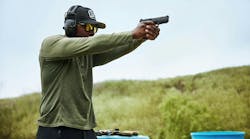Over the time that Borelli Consulting has been performing and writing equipment reviews for Officer.com, we've covered a lot of different lights. It occurred to me this past week that out of that entire collection of lights, there are a precious few that I still have and depend on. Realizing that, I thought it would be beneficial to the community to go over the lights that are still performing and have proven reliable. While this review is titled "Tactical Hand Held-Lights," there will also be a few weapon-mounted lights included, and it's important to realize that several of the hand-helds can be readily mounted to weapons--specifically long guns. In fact, one of the tidbits below describes how a collection of contemporary warriors used duct tape and SureFire 6Ps to create field-expedient weapon lights under emergency circumstances.
Let's start out looking at the line of handhelds from Night-Ops, part of the BlackHawk Products Group. A couple of years back, Night-Ops exploded onto the tactical lighting scene with their revolutionary Gladius. Driven by two 3V lithium batteries behind an LED lamp assembly, the Gladius' hidden strength was in the versatility of the tail cap. The patented turning selection switch allows the operator to choose from three functions:
- Touch on/Touch off: by pushing the tail cap, the light comes on and stays on. Touch it again to turn the light off. In this position the operator can also vary the light level produced. By touching and holding the activation button, the operator can turn on and then dim the light down to as low as one lumen. By releasing and then touching and holding again, the light can be "dialed" back up. Anywhere in the process, if the operator needs the full power light, he just releases the tail cap, touches it to turn the light off, and then quickly touches it again to turn the light back on.
- Strobe: the center position provides the operator with a strobing LED light for as long as the activation button is pushed (or, obviously, until the batteries die). What's cool is that the strobe rate is specifically set to cause disorientation in humans when the strobe is shined in their eyes. For law enforcement professionals, this adds another layer of non-lethal force. If you're dealing with a subject in a low-light situation, just turn on the light and shine it on his chest for general illumination and to make sure you can see his hands. With the light on, turn the tail cap one click to the center position. Now if you need to "ramp up," you can push the activation button and the light will start strobing. Of course, if you have to go to strobe you should be putting the light directly into the bad guy's eyes.
- Pressure on: the third position lets the operator produce light from the Gladius only while the activation button is pushed and held down. Many operators prefer this method of operation.
After taking the market by storm with the Gladius, Night-Ops followed up with more contemporary incandescent-driven six volt and nine volt lights they called the Falcata. The Gladius and Falcata marked Night-Ops' entry into the industry in a way no new light company has done. It was smart of them to make sure that the bezels of their lights fit most common filters and caps, and they produced their own holster system for the lights, the Mod-U-Lok. Not only does the Mod-U-Lok system hold their own lights, but because of industry standardization, it fits most of their competitor's products as well. I have two Mod-U-Loks on my gun belt and recommend all law enforcement officers do the same. As most police shootings occur in low-light circumstances, it only makes sense to insure we bring light with us. Using the old military axiom that "two is one and one is none," then it behooves us to have two decent flashlights on our person.
Next on my list of handheld tactical lights is from Pentagon Weapon Lights: the X2. Virtually all of today's hand-held lights are incorporating some type of anti-roll design feature so that you can put them down and not have them disappear on a slanted surface (within reason). The Pentagon lights have a five-sided (pentagon--get it?) end cap. Like most other contemporary tactical lights, the body is one inch in diameter and the head/bezel is 1.25 inches. Though not shown in this review, mounting systems exist so that you can put any one inch diameter tactical light onto a shoulder fired weapon. Pentagon Weapon Lights took this common system to the next level by developing their own mounting systems and providing added versatility through an auxiliary lighting system. For instance, you can get a Pentagon Weapon Light, like the X2, plus a smaller infrared light, in the same mount. Another option, and one I think would be of greater value for patrol operations, would be the X2 plus a smaller LED-driven light. This would allow for good light when searching for or engaging suspects, but would allow the use of lower levels of light when navigating or doing close-in security work.
Probably the best known name in the tactical light industry is SureFire. SureFire has been manufacturing tactical lights for decades now and was the driving force of today's contemporary standards such as the one inch diameter body and 1.25 inch bezel. SureFire lights have become synonymous with military special operations, and any "cool" cop in the late '80s or early '90s had a SureFire on their gun belt. SureFire was also largely behind switching the light industry over from measuring light output in candlepower to the more realistic and expressive measurement of lumens. Instead of seeing handheld spotlights advertised as producing two million candlepower, the market all of a sudden saw lights producing 65 lumens of light--and became aware of the difference. On the subject of lumens, I consider anything over 60 lumens to be sufficient for a personal hand-held light. For more specific high-risk or combat operations, obviously more is better. On a shoulder fired weapon, you probably want a light pushing at least 120 lumens, and 250 lumens is even better. The three inch "turbe" head on some SureFire lights was designed to give the hand-held light greater reach or distance. For the average patrol officer, at a minimum, I recommend two hand-held lights delivering a minimum of 65 lumens. It's better to have a 120 lumen light available with the 65 lumen light as your backup (or the light you hand off to your back up because he was dumb enough to show up without a light).
I would be remiss if I failed to mention SureFire's hand held torch, the M6. The M6 takes six 3V lithium batteries that are loaded into a battery cartridge to put into the light. The M6 produces an astounding 500 lumens of light. When I attended Low-Light Operations Instructor training, I was told that 500 lumens of light could do permanent retinal damage to a person if it was shone directly into their open eyes. To be honest, the 500 lumens of light is so bright that even if your eyes are closed and it's pointed at your face from within ten feet you're still going to turn your head. It's just BRIGHT. The downside is that 3V lithium batteries aren't cheap, and the M6 burns them up six at a time fairly quickly. Additionally, it's larger than the typical one inch body light and the 3 inch head makes it much wider. It's not convenient to carry on a gun belt, being better suited for placement in or on a tactical vest. I remind the reader that you still need a back up light, and if you're using an M6 as your primary, having a 120 lumen backup is a noticeable drop in light output.
To be honest, one of the biggest challenges with hand-held tactical lights is the pricing. Few of them cost less than $100, and those that do still need to be fed 3V lithium batteries. Enter the LightSaver Mini-Blitzer, imported exclusively in North America by Brigade Quartermaster. This hand-sized LED light is driven by two 3V lithium batteries (as is common in lights this size). The tail cap is multifunctional and provides you two light operations:
- Push and release to turn the light on
- Push and hold to get a flashing light
If you push and release to turn the light on, push and release again turns it off. To go from steady on to flashing, push and hold (just like if the light was off when you started). Once you get the light into flashing mode, you have to continue to hold the button or the light turns off. The body is made of aircraft grade aluminum alloy and is designed to prevent rolling. The three watt LED produces 75 lumens of light (according to the published material). It's a very clean light--so white as to almost look blue. Brigade Quartermaster markets a rifle mounting kit for this light, as well as a remote pressure switch tail cap assembly. Perhaps of greater importance to the officer paying for his own equipment out of his own pocket, the MSRP is $99.99.
That brings me down to weapon-mounted lights. The two that I specifically want to mention I have tested extensively and found to be comfortably functional. Both are made by SureFire. That's not to say that other weapon mounted systems aren't good. I put a Pentagon Weapon Light on one of my AR rifles; the other got a SureFire vertical grip light system. I'd mount a Gladius on a carbine in a heartbeat.
The first weapon mounted light system that I'd like to discuss is the SureFire 918FA, which is on my Remington 870. The light is integrated into the fore end and has switching options that allow for touch pressure activation or for turning the light on/off via a hard switch. The touch pressure is achieved via a pressure pad under your fingers (for right handed shooters) with the hard switch under your thumb. Obviously the fore end replaces the stock fore end that comes on a shotgun. I have two comments which are not criticisms, but are definitely considerations the operator has to take into account when deciding on a light system for his shotgun:
- The incandescent light assembly is fairly fragile. The bulb might break upon firing the first round, or it might not ever break. I went through two inside of about 50 rounds and have now had the third one in my 918FA for several hundred rounds.
- The battery is a replaceable stick that is the equivalent of three 3V lithium batteries. It's not as cheap to replace the battery stick as it would be to put in three new 3V lithium batteries.
I am a huge fan of having a light on the shotgun. When you add the power of controllable light to such a close-quarters combat effective weapon--not to mention the psychological impact attached to the sound of the action being pumped--you get a weapon that offers an appreciated increase in combat effectiveness.
The other mounted light system, and the last light system in today's overview, is the SureFire M500ab. SureFire makes an M500a and an M500b. The difference is the size of the bezel/lamp assembly and the inclusion of LED navigational lamps on the front end of the system. On my first AR style rifle I put an M500ab. I liked the system because it integrates the light housing directly into the fore end halves of the rifle. I find this more comfortable than having a set of Picatinny rails with a light attached. That said, if you need to attach another accessory, light, optic, etc. then the Picatinny rails are probably the better way to go.
Obviously this is not a comprehensive list of lighting options, tactical hand-helds or weapon mounted lights, but remember, just like the statement, "in the land of the blind, the one-eyed man is king," this statement "in the land of darkness, the man with the flashlight is king" is also true. If you don't own one, get TWO. When you need it most, one will break, the batteries will die, etc; or, sometimes even worse, your backup will forget to bring his flashlight and you have to hand one off to him. TAKE TWO. Two is one; one is none. It's only your life. What's it worth?



